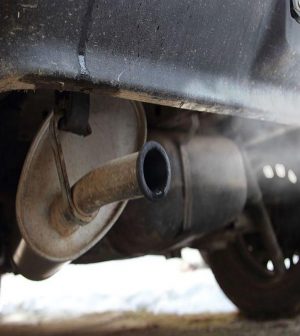- Skip Storing This Everyday Product in the Fridge Door
- Green Tea + B3 Pairing May Boost Brain Health
- Navigating Your Midlife Crisis: Embracing New Possibilities
- City Raccoons Showing Signs of Domestication
- Mapping the Exposome: Science Broadens Focus to Environmental Disease Triggers
- One Week Less on Social Media Linked to Better Mental Health
- Your Brain Changes in Stages as You Age, Study Finds
- Some Suicide Victims Show No Typical Warning Signs, Study Finds
- ByHeart Formula Faces Lawsuits After Babies Sickened With Botulism
- Switch to Vegan Diet Could Cut Your Greenhouse Gas Emissions in Half
Pandemic Data Suggests Cars Spew More Ammonia Than Suspected

COVID-19 lockdowns brought surprising news to scientists studying pollution: Cars spew much more ammonia into the air than previously thought.
Ammonia is a common air pollutant that’s a major cause of lung and heart disease, especially in cities.
“The tricky question has always been: How do we separate out ammonia concentrations owing to traffic from the ammonia emitted from sources like agriculture?” said study co-author Daven Henze, a professor of mechanical engineering at the University of Colorado Boulder. “Then the COVID lockdown suddenly provided us with a natural experiment.”
Henze and his colleagues analyzed data from Los Angeles County, which saw a 24% drop in traffic during the March 2020 pandemic lockdown.
The investigators used satellite images to assess ammonia concentrations in the air above Los Angeles before and during the lockdown. They concluded that vehicles account for 60% to 95% of ammonia emissions in the city.
State and national regulators had estimated that cars contribute less than 25% of ammonia air pollution.
“Our estimates for vehicle ammonia emissions are higher than federal and state inventories by a factor of two to five,” said lead author Hansen Cao, a postdoctoral researcher at CU Boulder.
The findings were recently published in the journal Environmental Science & Technology Letters.
The researchers now want to take a similar look at how the pandemic affected ammonia air pollution in other cities.
“Vehicles can be the dominant sources of ammonia emissions over urban areas,” Cao said in a university news release. “If we’re underestimating those emissions, then previous estimates of premature deaths owing to ammonia emissions might also be underestimated.”
It’s estimated that ammonia emissions from vehicles cause about 15,000 premature deaths in the United States each year, but recent studies such as this one suggest the actual number may be higher.
More information
The World Health Organization has more on air pollution and health.
SOURCE: University of Colorado Boulder, news release, Nov. 30, 2021
Source: HealthDay
Copyright © 2025 HealthDay. All rights reserved.










